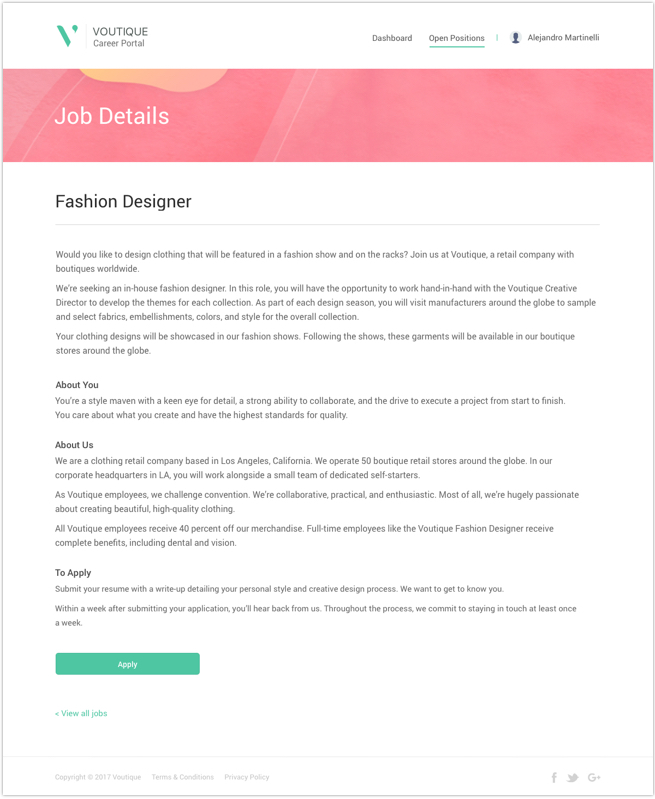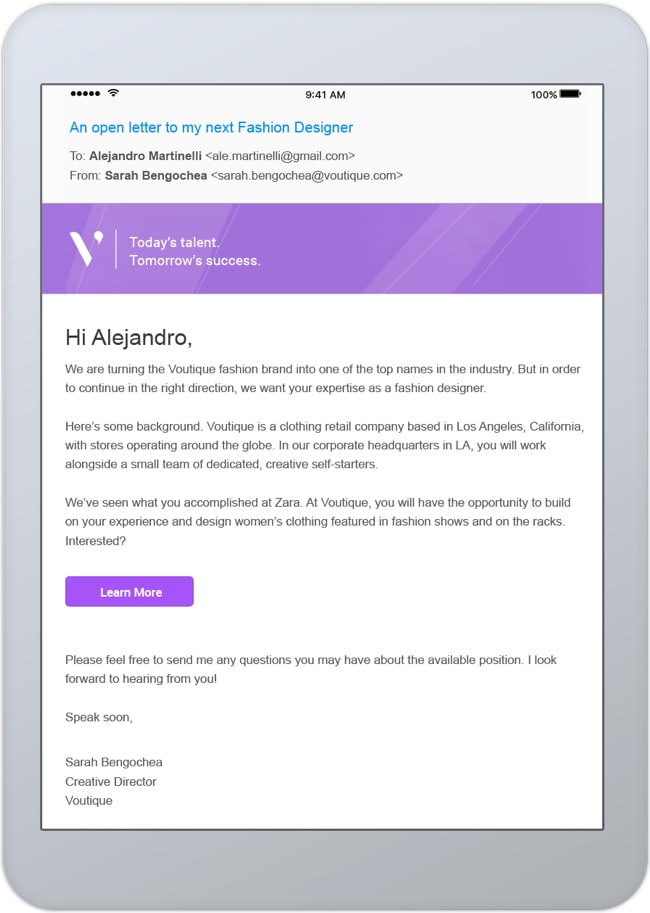The job description is one of the most critical aspects of the recruiting process. Consider the impact: a well-defined, appropriately promoted advertisement can draw the best talent to your company. In contrast, a lengthy and boring list of must-haves will repel candidates or, at best, give them pause.
When potential candidates consider changing jobs, their biggest roadblocks to applying are:
- not knowing what it’s like to work at the company
- not understanding what’s expected of the role
Want to ensure that candidates don’t hesitate to apply? Give your recruiters the proper tools and processes to engage the best talent.
How to write the perfect job description
1. Collaborate with the Hiring Manager
Hiring managers are recruiters’ best resources for crafting high-quality job descriptions. They know the day-to-day responsibilities of a given position and can help flesh out the key skills necessary for a candidate to excel. Prior to writing a job description, a recruiter should have a sit-down meeting with the hiring manager to ask about the particulars of the role. Critical points to touch upon include:
- responsibilities
- opportunities for growth
- role of this position within the organization
- team dynamics
While identifying skills is relatively straightforward, the more difficult task is pinpointing the personal aspects and abilities that a hiring manager seeks. In any case, it’s unlikely that a candidate would have all of a hiring manager’s desired qualities. So, most critically, a recruiter should zero in on one simple question: what is the most important ability or quality that would drive success? By developing more targeted job descriptions, employers can attract the best matches for the role.
Throughout the process, recruiters and hiring managers should be able to collaborate easily. Using Avature, a hiring manager can submit a request for a new position. After collaborating on the role, a recruiter can write a draft within the system and send it to the hiring manager to review, approve, or make changes before publishing the advertisement.
2. Highlight the Opportunities
When crafting the perfect job description, recruiters should highlight critical performance objective—not a laundry list of requirements. It’s time to nix the list of prerequisites. Particularly with entry-level candidates, potential can be more important than experience.
We spoke about this with Lou Adler, CEO and founder of The Adler Group training and search firm. Adler coined the term “performance-based hiring.” He believes that an applicant who meets all the requirements is not necessarily the most qualified.
“It doesn’t mean the person is both competent and motivated to do the work required,” he told us. “Worse, it overlooks all of the great people who can do the work, but who have a different mix of skills than those listed on the traditional skills-based job description.”
Instead, your recruiters can create a performance-based job description, which highlights the work itself and career growth opportunities. The advertisement should touch upon the job’s core challenges and responsibilities, as well as company culture and perks.
To incorporate the right elements into job descriptions, recruiters can ask themselves a few questions:
- Why should candidates apply?
- What do they receive as employees?
- What are the career opportunities?
By clicking the image below, check out an example of our mock clothing retail brand Voutique.
Why that last bit about communication? This matters to candidates: 53 percent of job seekers want expectations clearly outlined in the job description. Establishing an overall timeline keeps candidates in the loop, even before the process begins.
3. Ensure Search Engine Optimization
Crafting a top-notch job description serves little purpose without also factoring in SEO. Before posting the role, recruiters should optimize each job title for online search, rather than choosing a title that sounds flashy or fits directly into your org chart.
Take the above position of fashion designer. We could title this position Lead Fashionista or Senior Clothing Creator. However, for SEO purposes we focused on keywords commonly used in profiles and job searches. This way, search engine algorithms deliver the job post to the most relevant people. With this in mind, SEO works in your favor: candidates are more likely to click on your job if it matches their skills and experience.
4. Seek People for the Company—Not for the Job
Your talent acquisition team should also establish a standard template that includes the basic components for job descriptions across the organization. This can serve to highlight information about your company’s culture and mission, as well as the benefits you offer. After all, candidates have their priorities: they rank culture and values as what they most want to know about a potential employer.
From inside the company, it’s important to consider the kind of people you want to attract. Attitude, cultural fit, and personal drive—these components all make a difference in the long-term success of a hire. Encourage your team to weave company values into your job descriptions.
Using Avature, recruiters have access to a library of job templates. The library helps recruiters save time, particularly in the case of high-volume roles because they never need to write the same standard description twice.
5. Make the Most of Your Post
When it’s time to promote the job advertisement, recruiters should broadcast it across the widest range possible. Here, automation is key to maximizing efficiency. Using Avature, recruiters can schedule posts across job boards and social networks, from Monster to Facebook to Weibo. Recruiters should also gather applicants from no-charge channels, such as your internal network of employees.
Using email templates, recruiters can leverage your organization’s talent pools. Remind recruiters to keep their messages short, personal, and relevant—and always with a clear call-to-action. Again, automation is the name of the game. Consider the following branded email template, which we could send to prospects for our Voutique Fashion Designer opening.
Beyond email, your organization should make it easy for candidates to apply. Using Avature, candidates can apply straight from their mobile phone using their social media credentials or by uploading their resumes from Google Drive or Dropbox.
6. Enable Visibility
Once the job post is published and people begin to apply, all stakeholders should be able to maintain visibility of the candidates. Hiring managers can use Avature to keep track of requisitions, see candidates’ information, add notes, send emails, make calls, and move candidates through the process.
In today’s competitive talent market, crafting and promoting your job posts is of utmost importance. With the right technology partner, your talent acquisition team can complete these tasks efficiently and collaboratively—all to ensure that the best talent applies to your organization.



